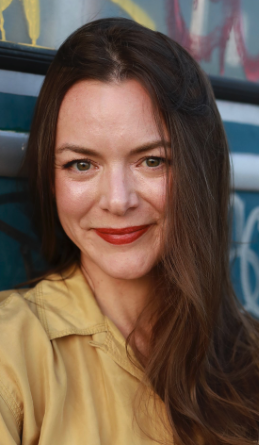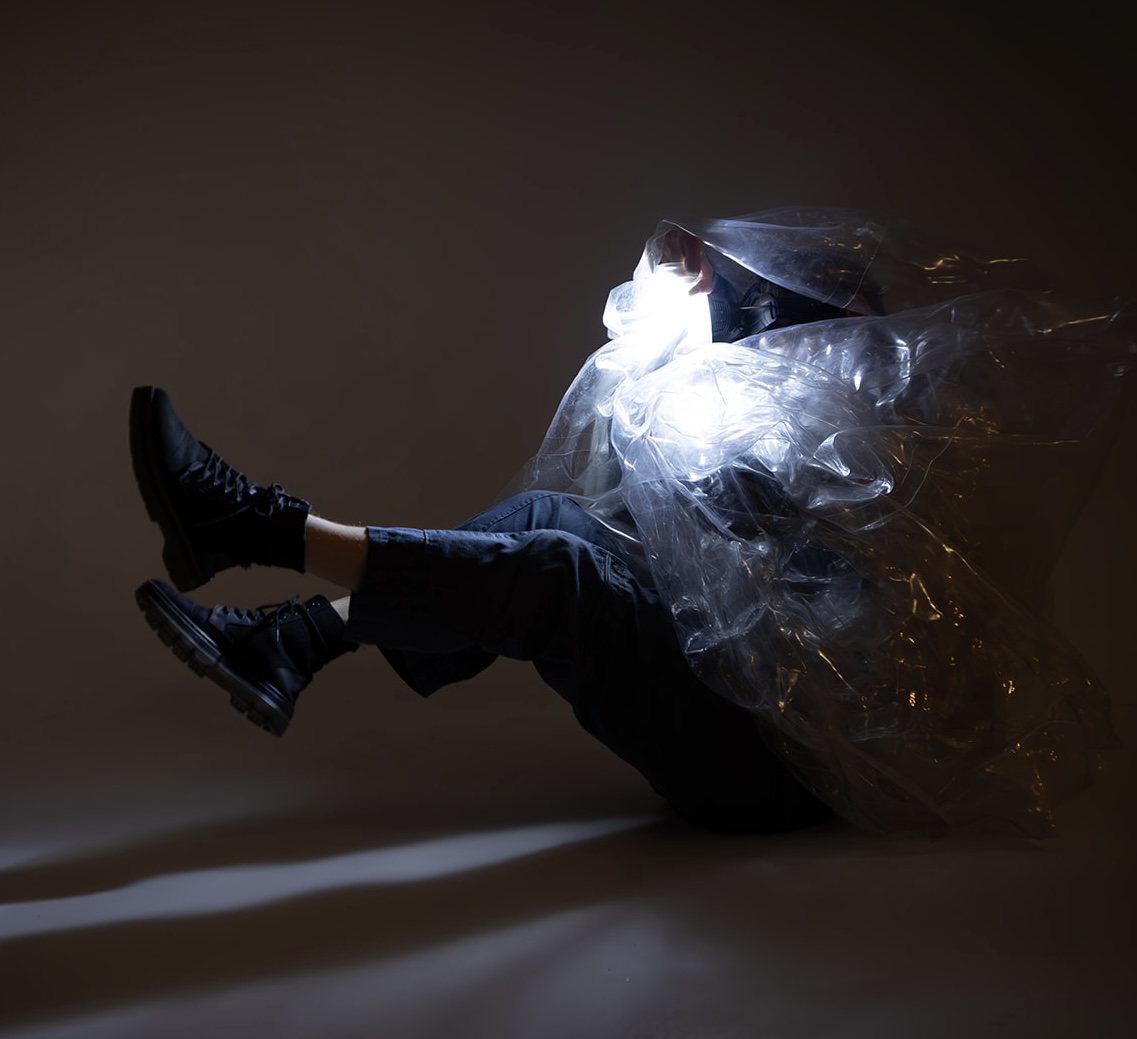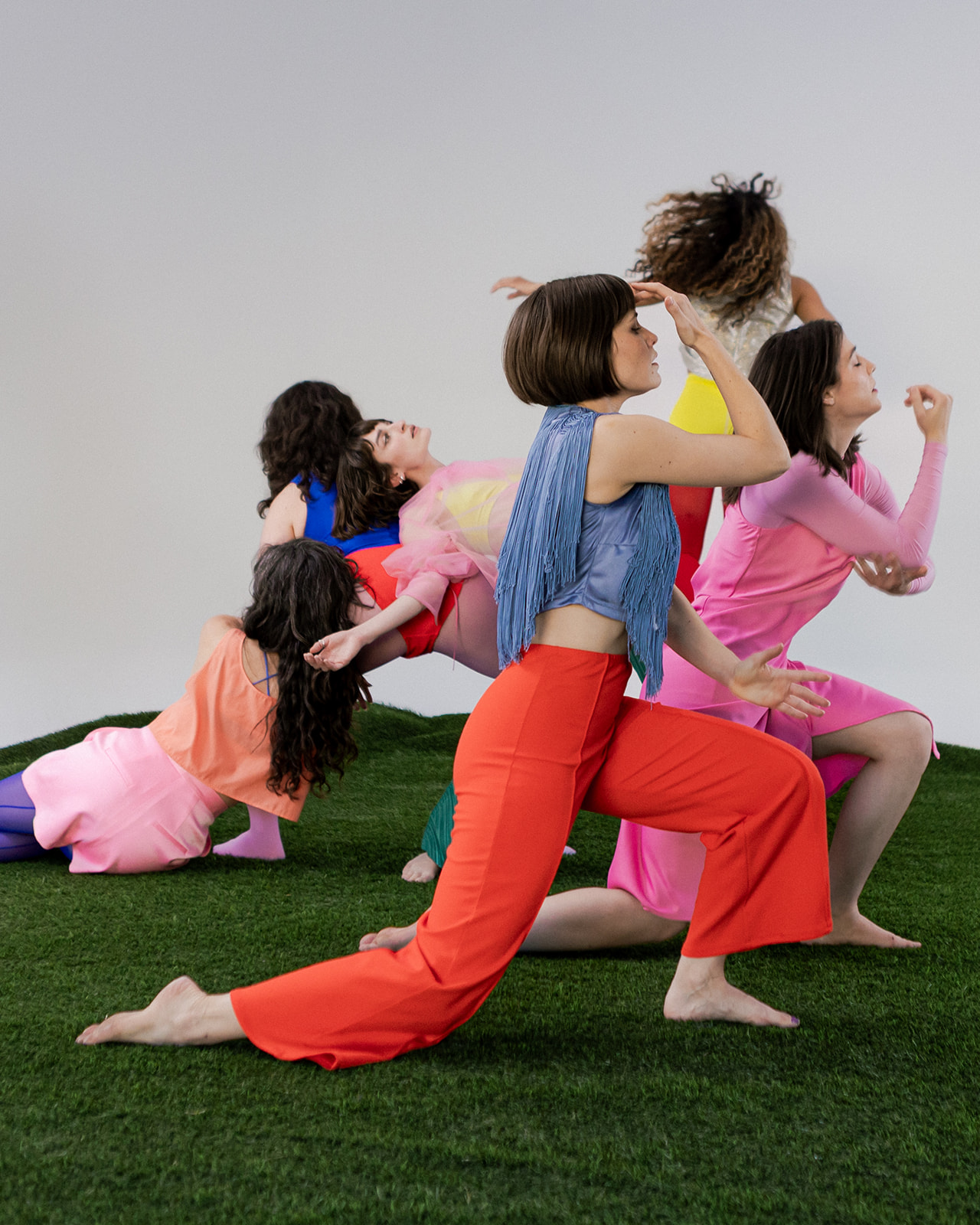Review: Premiere by Allysen Hooks Projects
by David Glen Robinson
 Allysen Hooks Projects, one of the newer dance companies in Austin, was inaugurated in 2024. Hooks, its producing artistic director, is a native Texan who moved e to NYC arly on and earned degrees from Julliard and Sarah Lawrence, then pursued her dance career in NYC for seventeen years. She brings to Austin is a fresh take on contemporary dance and a future-forward philosophy. As she phrases it, “I construct surrealist narratives aimed to capture nuances of the human condition. Crafting dreamlike logic, I invest in how far, how clearly, how resonantly I can push the boundaries of a molded universe.”
Allysen Hooks Projects, one of the newer dance companies in Austin, was inaugurated in 2024. Hooks, its producing artistic director, is a native Texan who moved e to NYC arly on and earned degrees from Julliard and Sarah Lawrence, then pursued her dance career in NYC for seventeen years. She brings to Austin is a fresh take on contemporary dance and a future-forward philosophy. As she phrases it, “I construct surrealist narratives aimed to capture nuances of the human condition. Crafting dreamlike logic, I invest in how far, how clearly, how resonantly I can push the boundaries of a molded universe.”
Hooks’ work is on display this weekend as Premiere/DadaLab, an evening-length dance performance at DadaLab on Alexander Street in east Austin. The nine-member ensemble presents two works, “Ordinary Ephemera” and “I’m Trying to Feel Something.” Hooks's collaborators are Anna Bauer, Cellise Brown, Erin Ellis, Taryn Lavery, Christina Mitchell, Rosalyn Nasky, Aidan Rogers, Melissa Sanderson, and Camille Wiltz. They created too many memorable moments to describe fully.
“Ordinary Ephemera” is a restaging from Hooks’s time in NYC. The tone is dreamlike, starting with two slow dancers in nude-toned tights in shapes on the marley floor. The sensation is of gravity upended, 3D floating in the dreamtime. The first major surprise comes with the entrance of a huge plastic bubble with a seminude female figure inside it, apparently in some distress, seeking a way out of the bubble as it rolls across the stage bumping into the blank walls. A stagehand in coveralls and a caver’s headlamp assists the rolling image, in one instance keeping it from knocking over a speaker tower . Eventually, the stagehand pulls the figure out of the collapsed bubble like a hatchling breaking out of the egg. The figure lies unconscious on the marley, and the stagehand is born as a dancer, Anna Bauer, tasked among other duties to illuminate the actionwith her headlamp for the remainder of the piece. Some of those duties give us another surprise. Bauer gathers the crumpled bubble/egg and holds it against the blank upstage wall and shines the headlamp into the plastic mass. The crumpled bubble becomes a crystal sculpture on a museum wall, the headlamp’s ilumination sharply refracted throughout the sculpture. Bauer then exits stage right, pausing a few times to create other sculptural shapes against the wall.

Bauer returns and is joined by a black shadow figure that begins to mirror her every movement and gesture. Bauer continues lighting the stage with her headlamp, then illuminates a major surprise. Rosalyn Nasky, costumed in wide strips of cloth, enters clutching a miniature bubble to her chest. Nasky, an absolutely spectacular artist, projects awareness of every cell of her body and all her surrounding environment. She dances with the balloon, out of scale with the bubble/egg but symbolic of it, and she finishes by releasing her balloon to rise into the DadaLab rafters.
Attention returns to Bauer, who slowly explores the now-crushed plastic of the original bubble. She opens it and with deliberation climbs inside, an impossible return to the chrysalis, very much against nature but avery much in keeping with the disjunct progression of dreams. Great credit to Anna Bauer for her complex and successful work in this piece. And, ah, the dreams of Allysen Hooks (who was the figure inside the first large bubble).
The soundtrack for “Ordinary Ephemera” was comprised of edited pieces by musicians Duane Pitre, Nana April June, Leila Bordreuil, Jasmine Guffond and Erik Skodvin, and Tim Hecker; the soundtrack of “I’m Trying to Feel Something” was entirely an original composition by Jordan T. Chiolis. His concept was similar to the continuous tone music of early Philip Glass. The pieces here are of the type some characterize as “modulated static” or “hammered white noise.” The droning tracks, too loud mostly, nevertheless served to create an otherworldly, dreamlike atmosphere under which the imagery played to delight or frighten.
 Hooks's new piece “I’m Trying to Feel Something” picks up the quest to express the surrealism of dreams with new tools and methods. The talented six-member ensemble ran, flew, and slithered onstage to create many abstracted images with their bodies and certain very interesting props. It started with several dancers clustered in the upstage left corner of the stage. But downstage right one dancer, Erin Ellis, bounced up and down on a small trampoline, holding a live microphone. She seemed to hold a count, speaking semi-audibly into it while the upstagecluster slowly moved out, a ten-legged shapeshifting monster lifting someone high on the upstage wall to hold a spire- or arrow-shape, or dropping a dancer to the floor to lie supine. This continued through many images and various dancer combinations. In contrast to “Ordinary Ephemera,” costumes were brightly colored, layered, loose or tight, and nonmatching. The statement was clearly one of diversity, somewhat kaleidoscopic, and not one of unity or harmony.
Hooks's new piece “I’m Trying to Feel Something” picks up the quest to express the surrealism of dreams with new tools and methods. The talented six-member ensemble ran, flew, and slithered onstage to create many abstracted images with their bodies and certain very interesting props. It started with several dancers clustered in the upstage left corner of the stage. But downstage right one dancer, Erin Ellis, bounced up and down on a small trampoline, holding a live microphone. She seemed to hold a count, speaking semi-audibly into it while the upstagecluster slowly moved out, a ten-legged shapeshifting monster lifting someone high on the upstage wall to hold a spire- or arrow-shape, or dropping a dancer to the floor to lie supine. This continued through many images and various dancer combinations. In contrast to “Ordinary Ephemera,” costumes were brightly colored, layered, loose or tight, and nonmatching. The statement was clearly one of diversity, somewhat kaleidoscopic, and not one of unity or harmony.
The live microphone was used for spoken words at three points in the dance by different dancers, Erin Ellis on the trampoline being the first. Christina Mitchell’s vocal segment was that of someone much fatigued and out of breath. Her section took a surprising turn when the other dancers picked up and held the trampoline verticall. Mitchell struck the trampoline and bounced off several times as though it had been transformed into the magical mirror of many wicked queens, except that it was opaque and did not give Mitchell an image. This was an interesting commentary on identity denied or on seeking identity but not gaining it.
A mini critique: Mitchell did not push into the trampoline enough to bounce off realistically. A bit more rehearsal would have helped.
The athletic Taryn Lavery was the third speaker, and she showed skill in speaking clearly while being elevated, bent over, turned upside down and slung in circles around the floor. Lavery is a trouper. “I’m Trying to Feel Something” continued through many more sequences and images, making the total show worth seeing more than once. The piece could have benefited, however, from more choreography in the transitions, entrances, and exits. Most of those were either running or pedestrian slow walks. Simple dance steps would have increased the feel of it all happening in Wonderland.
Allysen Hooks explores the qualities of dream states and dreamscapes in the process of dream logic. Dream logic? Not the same logic you learned in algebra class. Story features and characters come out of nowhere and somehow seem to fit into the unspooling wonderland or nightmare of the dreamer. One thing is true: we all own our own dreams. Videographers typically appreciate the fast-cut editing of their dreams. Many music videos have that quality too, but video editors often strive to work their imagery into a linear narrative for the sake of visual storytelling. They’re under contract after all. Cinema has less concern with dream logic, but one filmmaker who did was David Lynch. Ask anyone who caims not to understand his movies. Lynch sets up the horror in his viewers’ dream life by following linear plots in the first two-thirds of his movies, and then changing story lines (narrative logic), props, character names and faces, in Mulholland Drive even marching foot-high puppets out of the closet straight into the viewer's subconscious. Conveying imagery in a dreamlike way is the point. Few artists can do it or even try, but Allysen Hooks scores with Premiere/DadaLab. Her comment about expanding the boundaries of a molded universe reveals powerful ambition. We want to see more.
Premiere/DadaLab had its distractions in an otherwise exemplary and innovative performance. The only one worth mentioning is related to the recent trend of dancers to work with exceptionally long hair. The lack of restraint of such hair styles created distractions. In an early duet, an example of standing apart and facing the audience showed one dancer presenting the face clearly and the other with long, ropy hair completely obscuring the face, the dancer happy with the result. When the dancers were in contact, more than once the long, moplike hair was over both dancers’ heads. This led to cotemplating choice, intentionality, and oversight. It boiled down to alternatives. If the dancer was left with the option to perform without hair shortening or restraints, then the obvious likely distractions stemmed from amateurish indiscipline. If the flyaway hair was an intentional choice on the part of the choreographer, then that was a choreographic fail. Not happy either way.
The strength of concept, the energy of performance, and the high talents involved, namely Rosalyn Nasky, Anna Bauer, Taryn Lavery, Aidan Rogers, Melissa Sanderson, and all the others, overwhelmed all the glitches and missteps. Kudos to all. The talent, concept, and technical production skill (thanks again to Steven Pruitt) produced a truly memorable dance concert and perhaps a turning in the pathway of Austin dance.
Premiere/DadaLab runs until April 27 at DadaLab in east Austin.
Premiere
by Allysen Hooks
Allysen Hooks Projects
Friday April 25, 8 pm (doors open 7:30pm)
Saturday April 26, 2 pm (doors open 1:30pm)
Saturday April 26, 8 pm* (doors open 7:30pm)
Sunday April 27, 2 pm (doors open 1:30pm)
*Q&A and cocktail hour to follow
---
Tickets are priced sliding scale $30+*
Thank you for your consideration of an increased ticket sale as contribution to support our run of shows and to champion future projects.
We are so grateful to our enthused and growing donor base. This work is made possible solely by your generosity and your belief in the value of our dance work in the Austin arts community.
Access to our tax-deductible donation platform will be available in the performance program, and here.
*If cost is a deterrent please email allysenhooks@gmail.com for a discount code.
